Isabella Bradford's Blog, page 54
June 18, 2016
Breakfast Links: Week of June 13, 2016
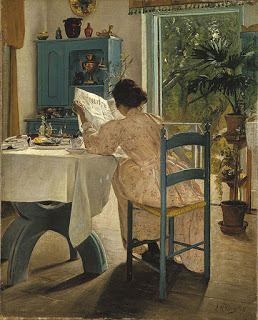 Breakfast Links are served - our weekly round-up of fav links to other web sites, articles, blogs, and images via Twitter.
Breakfast Links are served - our weekly round-up of fav links to other web sites, articles, blogs, and images via Twitter.• Circassian bloom : cheek rouge for 18thc and 19thc ladies.
• "My present dreadful situation": the perils of fame as an 18thc actress .
• Tabasco and the war against bland military meals.
• Jane Austen's manuscripts are finally all digitized, and may now be viewed as a whole online.
• Video: If you're a Regency era lady, a new spencer jacket is a great way to spruce up your look for summer.
• Converting Jews to Christianity in Regency England, 1809-1813.
• Lavish lace in the Martha Washington collection at Mount Vernon.
• What spilled ink and fingerprints reveal about medieval manuscripts.
• Soldier newspapers in the American Civil War.
• Epic battles in medieval manuscripts: knights vs. snails.
• Image: Pretty much all you need to know about Victorian children's literature .
• What did it mean to be called an Amazon during World War One?
• Why memes matter for feminism.
• America's mid-century rest stops were real roadside attractions.
• A Coney Island pie-maker invents the hot dog , 1870.
• Built around 1780, this Federal-style house in what is today Chinatown, NYC, managed to survive until the 1920s.
• Image: Dante Gabriel Rossetti in his Chelsea home.
• Eight places associated with the wives of Henry VIII .
• Uncovered in Hyde Park: 165-year-old toilet remains from "spend a penny" exhibition.
• The Endicott pear tree : still alive in Massachusetts after nearly 400 years.
• Blood, controversy, and puddings in early New England.
• Changing concepts of time : art in a speeded-up world.
• Image: Medieval church door in Gloucestershire believed to have been the inspiration for J.R.R. Tolkien's entrance to Moria.
• They marched with torches: getting out the vote , 1840-1900.
Hungry for more? Follow us on Twitter @2nerdyhistgirls for fresh updates daily.
Above: At Breakfast by Laurits Andersen Ring. Private collection.
Published on June 18, 2016 14:00
June 16, 2016
Friday Video: What Did Shakespeare's English Sound Like?
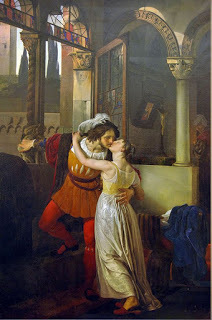 Romeo & Juliet
Loretta reports:
Romeo & Juliet
Loretta reports:Not long ago, I posted a short video about the way the English language has changed over the centuries.
I raised the question about how understandable Shakespeare’s English would be to modern audiences: not only in the sense of unfamiliar words and phrases but also in terms of the sounds.
Lo and behold, wandering through YouTube at some point when I probably should have been working on the WIP, I found the answer as well as more glimpses of what goes on at the new Globe theater .
Image: Francesco Hayez, L'ultimo bacio di Giuletta e Romeo (Romeo and Juliet's Last Kiss)
Clicking on the image will enlarge it. Clicking on the caption will take you to the source, where you can learn more and enlarge images as needed.
Readers who receive our blog via email might see a rectangle, square, or nothing where the video ought to be. To watch the video, please click on the title to this post.
Published on June 16, 2016 21:30
June 15, 2016
More About "Sir Joshua Vanneck and Family",1752
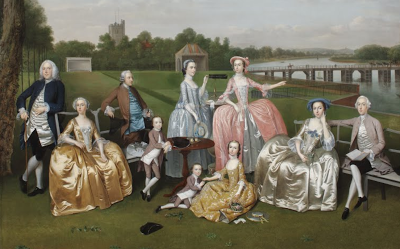
Isabella reporting,
One of the things that Loretta and I enjoy most about this blog is learning from each other, and from our readers. Whenever we write a post with questions or things we don't quite understand, there's always someone out there who knows the answer. My recent post about the painting Sir Joshua Vanneck and Family by Arthur Devis (detail above; click on the image to enlarge it) inspired such interesting comments that I thought I'd share them here.
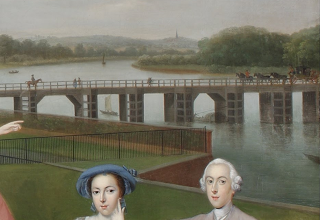
The first comment came from my fellow Nerdy History Girl, Loretta, who has a fine eye for old London landmarks, and at once recognized the bridge in the background, detail right, as the first Putney Bridge. Designed by architect Sir Jacob Acworth, the bridge was opened in 1729; legend says that the bridge was built after Sir Robert Walpole was unable to cross the river for an important meeting with King George I on account of a drunken ferryman. Loretta forwarded this slightly later image of the bridge from Picturesque Views on the River Thames Vol. II (1802); to the right you can also see the same square church tower that is in the Vanneck portrait.
Loretta also shared a quote about the bridge from Old and New London, Vol. 6, 1878. By this time, over a century after the painting, the old bridge must have seen better days: "Putney Bridge cost upwards of £23,000; it is not only a disgrace to the neighbourhood, considered as an object of use and necessity, but is more dangerous to boats upon the river." You can read more here .
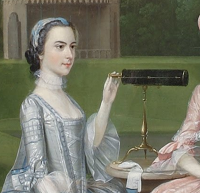
When I shared the post on Twitter, I heard from Rebekah Higgitt, a Historian of Science and a Lecturer at the University of Kent. She pointed out that the small telescope used by the Vanneck ladies, detail left, to survey the river was very similar to this portable reflector telescope made c1750, and now in the collection of Royal Museums, Greenwich.
Finally, there is this comment from Sarah Hall, Director of Curatorial Affairs at the Frick Museum of Art, where I first saw the Vanneck painting last week. She had much more information to contribute regarding the Vanneck family, the mystery of Roehampton House, and the painter, Arthur Devis:
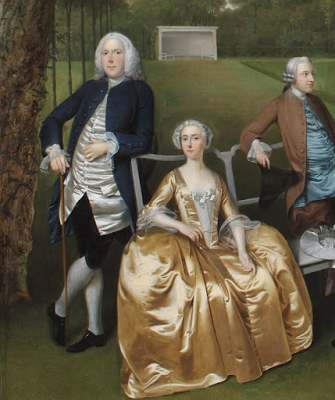
"[Devis's] way with fabrics is superb - although he often used figures/dolls in the studio to help him work out his composition - so the faces and figures tend to look similar and not have any real weight to them. The painting was made two years after [Sir Joshua's] wife died, so she is not included. There is no record of the sitters, but scholarship suggests the portrait may have been commissioned to celebrate the marriage of his daughter Anna Maria (in pink), and the subjects are likely (left to right): Sir Joshua, Mrs. de la Mont (likely his sister), Henry Uthoff (Anna Maria's husband), Gerard (son), Gertrude (daughter, with telescope), Joshua (son, on ground), Margaret (youngest daughter, on ground) , Anna Maria, Elizabeth (eldest daughter), and Thomas Walpole (Elizabeth's husband and cousin of Horace Walpole). They did live on an estate at Roehampton on the banks of the Thames which was known as Roehampton House - his son made extensive renovations and changed the name to Roehampton Grove - hence the confusion with what is now known as Roehampton House. Many wonderful details in this - I love the flowers strewn about strategically, and the glint of shoe buckles and hat trim, and the date and signature, camouflaged in the bark of the tree at left. The clothing is so beautiful, the figures are like frosted pastries."
So the Vannecks are in fact posing on the grounds of their own house. I'll admit I'm relieved to learn they're not trespassing in their beautiful silk clothing. That's Sir Joshua and his sister in the detail, lower right, with Henry Uthoff to one side (and doesn't Henry look as if he shares a tailor with Thaddeus Burr , as painted by John Singleton Copley?)
But Loretta came up with one final, scathing comment on Sir Joshua's house, also from Picturesque Views on the River Thames:
"Amongst the many elegant mansions that adorn the village of Putney, few have been erected on the banks of the Thames. That of the late Sir Joshua Vanneck stands conspicuous, but has nothing about it to render it an object worthy attention."
Oh, my....
Many thanks to Sarah Hall, Rebekah Higgitt, and of course Loretta for their contributions to this post.
"Sir Joshua Vanneck and Family at Roehampton House, Putney" by Arthur Devis, 1752, Frick Museum of Art, Pittsburgh.
Published on June 15, 2016 21:00
June 14, 2016
A Wicked Pursuit and Lord of Scoundrels Special Sale
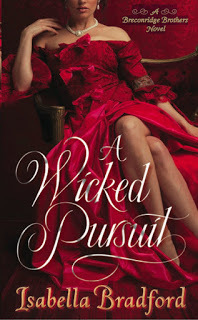 Loretta & Isabella report:
Loretta & Isabella report:Yes, today’s post has nothing to do with history but with our real job—the one that pays: writing novels.
Today we offer a pair of eBook bargains.
From now until 18 June the eBook of A Wicked Pursuit —the first in Isabella’s Breconridge Brothers series—is on sale for $1.99
You can get your Amazon Kindle deal here
and your Barnes & Noble Nook edition here.
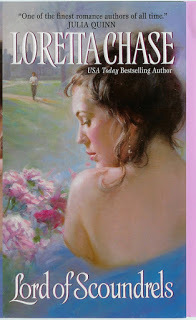 And as mentioned previously,
Lord of Scoundrels
is the featured June book for
Avon Romance’s Diamond Anniversary
.
And as mentioned previously,
Lord of Scoundrels
is the featured June book for
Avon Romance’s Diamond Anniversary
.As part of the celebration, the eBook is on sale for $1.99 through the end of this month.
You can get your Amazon Kindle edition here
and your Barnes & Noble Nook edition here.
Please note: The Two Nerdy History Girls have different publishers with different publishing and licensing arrangements.
This is why readers in the U.K. can get a £1.99 deal for Isabella’s book while Loretta’s bargain price applies only to the U.S. and Canada.
Clicking on the image will enlarge it.
Published on June 14, 2016 21:30
June 13, 2016
Relics of Old London, 1875-1886
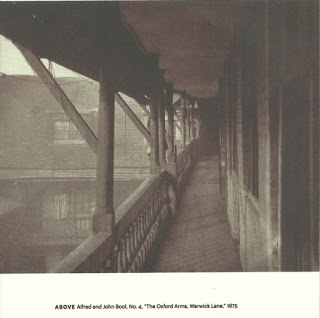
Loretta reports:
Thanks to an overnight visit to New Haven this past weekend, I was able to make two visits to the Yale Center for British Art . During the first, I made my way to the fourth floor gallery, one of my favorite places, to view the new display of the collections, “Britain in the World.” You can read about it here .
On the second visit, I spent a long time in a small, fascinating exhibit, Art in Focus: Relics of Old London, which runs until 14 August 2016.
On display were beautiful carbon photoprints of London buildings in the later Victorian era. These were part of a project begun in 1875 when “ a group of friends united to memorialize”* the Oxford Arms coaching inn, which was facing demolition. “Over the following decade, the Society for Photographing Relics of Old London continued to issue photographs of buildings that were abandoned, altered, or soon to be destroyed, to honor bygone and overlooked sites and to rouse public sentiment against such development projects.”
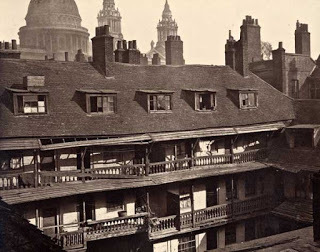 Oxford Arms, the galleries
Oxford Arms, the galleries
Since I like to write road books, I was especially interested in the photos of old coaching inns. But all of the images give one a sense of time travel.
The exhibition photographs come from the Paul Mellon Collection, and are part of a complete set of 120 photographs the museum owns. The photos were originally issued in “portfolios of green morocco leather, with gilt lettering.” This, and the decision to produce carbon prints, which are highly stable and thus permanent, show that the images were meant to be a lasting record. According to the exhibition pamphlet, “the accompanying letterpress included detailed scholarly excavations of the layers of history in each site photographed.”
You can see the images and the descriptions at the Royal Academy Collections .
I also recommend a visit to one of the 2NHG’s favorite London blogs, Spitalfields Life , where you can see some Then & Now: Relics of London photos to compare with photos of the buildings that escaped destruction.
*All quotations from exhibition catalog: Art in Focus: Relics of Old London , Yale Center for British Art.
Image: The Upper Gallery, The Oxford Arms, Warwick Lane, 1875, ca.1875, scanned from Exhibition catalog (Note: the copyrighted images at, e.g., the Royal Academy of Arts, are much sharper. Oxford Arms, the galleries, looking from Warwick Lane , courtesy Wikipedia.
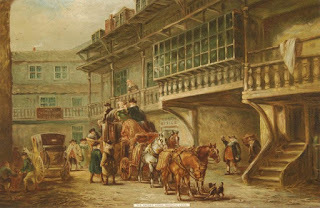 Oxford Arms in Better Days
Oxford Arms in Better DaysNote: For those readers who are joining the Lord of Scoundrels read/re-read-along this month , Jessica would have watched the fight from a gallery like this, but in much better condition, obviously in 1828. Unfortunately, I lost the link to the image at left.
Clicking on the image will enlarge it. Clicking on the caption (except for the one at left) will take you to the source, where you can learn more and enlarge images as needed.
Published on June 13, 2016 21:30
June 12, 2016
Fine Fashion from "Sir Joshua Vanneck and Family", 1752
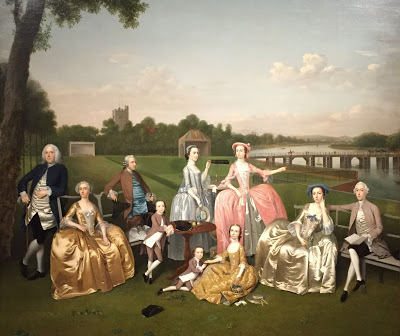 Isabella reporting,
Isabella reporting,This past weekend, I visited the Frick Art & Historical Center in Pittsburgh, PA. I was at the art museum primarily to see the exhibition Killer Heels (more about that in a future post), but I also stopped by the European galleries. There I discovered this painting: Sir Joshua Vanneck and Family at Roehampton House, Putney by Arthur Devis.
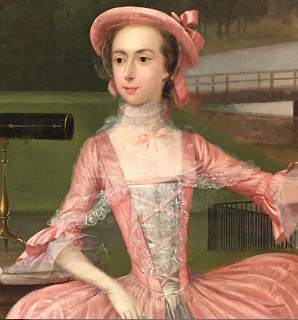
It's what is known as a "conversation piece," a specific style of painting popular in 18thc Britain that usually shows the gentleman who commissioned the painting surrounded by his family in an elegant setting to display his wealth and taste. In theory, the people in the painting have been captured in a conversation, or engaged in a well-bred pastime such as drinking tea, playing music, or resting after a long walk.
Sir Joshua Vanneck (1702-1777) was born in The Hague and emigrated to London, where he became a successful merchant - though not quite successful enough to afford the house and grounds of Roehampton House, which appears in the painting, and which was owned by the Cary family. (The Vannecks' house was Heveningham Hall, Yoxford, Suffolk.) Sir Joshua and his extended family must have been strolling the grounds as visitors. Sir Joshua's full title was 1st Baronet Vanneck, of Putney, Surrey, where Roehampton House is located, and likely explains the reason for the setting.
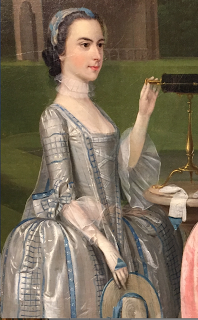
As 18thc artists go, Arthur Devis (1711-1769) is never mentioned in the same breath as Georgian giants like Joshua Reynolds or Thomas Gainsborough. The painted Vanneck family could all be little dolls, their expressions nearly identical and their anatomy a bit uncertain. But as a chronicler of fashion, Devis shines. The silk gowns not only possess the perfect glossy shine, but also reveal slight puckers along the seams, and the lace trimmings are exquisitely captured, with the curving detail (I'm guessing) carved into the thick paint with the pointed end of the painter's brush.
The Vannecks are all stylish, according to their ages: Sir Joshua and his wife Mary Anne are conservatively dressed in clothes that are a bit old-fashioned, while their twin sons Gerrard and Joshua are dressed in the simpler versions of the adults' clothing. The young women in the center - daughters Margaret, Elizabeth, Anne Maria, and Gertrude (though I confess I don't know which is which) - are of course the most fashion-conscious.
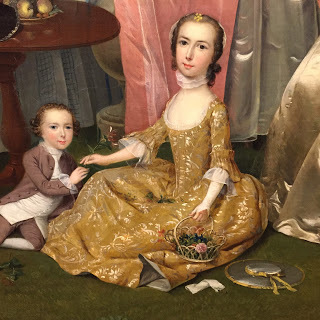
I've pulled out several of my favorite details - as always, please click on the images to enlarge them. The embroidered kerchiefs, ruffles, and aprons (probably silk gauze or fine linen) are sheer enough to be layered over one another. Patterned ribbons zig-zag across their stomachers, the pointed inserts on the fronts of the gowns. The shapes of the hoops beneath the skirts are clearly defined. Caps are worn beneath the broad-brimmed hats. All three of these young ladies are wearing white fingerless mitts lined with a colored silk to match their gowns; you can see the pointed tips flipped back to show the contrasting pieces. And I love how the younger brother, about eight years old, is already wearing his hair in neat rows of side curls, pinned in place on either side of his face like an adult.
Details, Sir Joshua Vanneck and Family at Roehampton House, Putney by Arthur Devis, 1752, Frick Museum of Art, Pittsburgh.
Published on June 12, 2016 18:10
June 11, 2016
Breakfast Links: Week of June 6, 2016
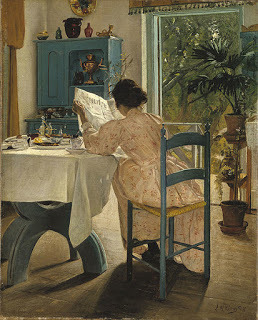 Breakfast Links are served - our weekly round-up of fav links to other web sites, articles, blogs, and images via Twitter.
Breakfast Links are served - our weekly round-up of fav links to other web sites, articles, blogs, and images via Twitter.• Dick Turpin , 18thc butcher and highwayman.
• America's bloody history: five famous dueling grounds.
• Why these anatomical models of women are not disgusting.
• The heraldry windows of Chawton House Library, here and here .
• How a chemical engineer returned home from World War Two and created a company that led to the... Tunnel of Fudge .
• Photographs that remind us what polio – now nearly wiped out world-wide – once looked like.
• Image: A c1900 bodice with built-in bust enhancers .
• "The Newsboy is a trifle profligate": sketches of New Yorkers from 1840s.
• A gold "safety pin " from the 7thc BC.
• Louisa Catherine Adams, the first and only foreign-born First Lady.
• Will the last person to leave Regency England in 1816 please turn off the light?
• Image: From an 1880 census , Ellen Adams' occupation is "taking it easy."
• Fascinating obituary for Jane Fawcett , who went from being a London debutante to a decoder at Bletchley Park who helped doom the Bismark.
• For Outlander fans: ten things you (probably) didn't know about Bonnie Prince Charlie and the Jacobites .
• A soldier of the Massachusetts line, 1777.
• Star-shaped Sunday school badge honoring Queen Victoria's Golden Jubilee in 1887.
• Image: Grand Central Terminal, NYC, by John Collier, 1941.
• What would Britain be like today if Charles II had been captured and executed in the 17thc?
• The murder confession of Mary Voce , 1802, which inspired George Sand.
• Discover the hair industry of the past through a 19thc hairwork buckle.
• Gabrielle d'Estrees , mistress of the French Henri IV.
• Stuck on 1962: the ghost advertisements in London's abandoned underground stations.
• Image: Some days, exactly, c1800.
Hungry for more? Follow us on Twitter @2nerdyhistgirls for fresh updates daily.
Above: At Breakfast by Laurits Andersen Ring. Private collection.
Published on June 11, 2016 14:00
June 9, 2016
A Friday Video from the Archives: An 18thc Gentleman Longboards Through Bath
Isabella reporting,
A surprisingly energetic video for a lazy Friday in June, and well worth a repeat performance. Combine an 18th c. gentleman (well, at least that's what he's supposed to be) on a longboard, the beautiful streets of Bath, and a dash of Iron Maiden, and you get Georgian shredding, dude. (I'm sorry about the inevitable advertisements, but a quick click on the X will make them vanish.)
Published on June 09, 2016 21:00
June 8, 2016
Parisian Porters in 1835
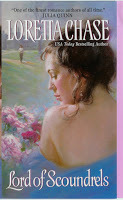 Loretta reports:
Loretta reports:As part of Avon’s Diamond Anniversary, they’re highlighting certain of their books, one a month. Since my historical romance, Lord of Scoundrels ,* is being honored this month, I’ll be offering bits of related research.
One personage who appears in the first part of the book is the porter for the apartment building in Paris in which the heroine’s brother lives. The porter was the all-purpose servant for everybody in the building.
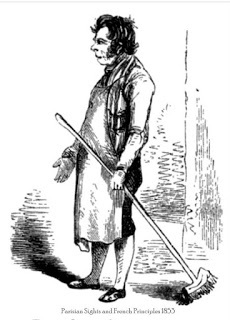 Porter of Paris
Porter of Paris
When I wrote the book, believe it or not, I had no access to the Internet. Google didn’t exist. My main source was Frances Trollope’s Paris and the Parisians in 1835.** As is often the case in travel writings, the author’s attitudes and prejudices color her observations. My English characters reflect some of these views, though I may tone them down a bit to accommodate my readers’ sensibilities. (In historical romance, it’s always a balancing act, on so many counts.)
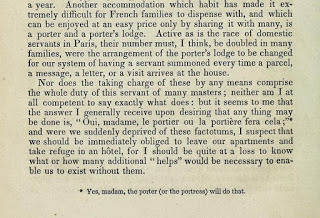 Porter of Paris
In any case, as Ms Trollope makes clear, the position entailed a great deal more than that of the porter in a large English establishment, where many other servants, especially footmen, were available to perform various tasks.
Porter of Paris
In any case, as Ms Trollope makes clear, the position entailed a great deal more than that of the porter in a large English establishment, where many other servants, especially footmen, were available to perform various tasks.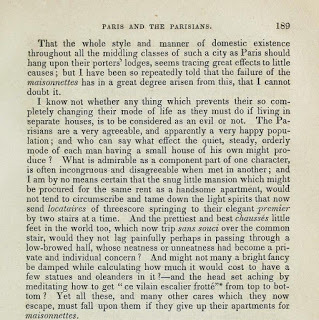 Porter of Paris
Porter of Paris
You may wish to continue reading the chapter (just click on the link under the image and continue paging through): The author makes some interesting points about Parisian vs London modes of living.
If I understand correctly, the porter/concierge is still part of Parisian apartment life, albeit he/she seems to be a dying breed. Parisian readers, please feel free to chime in!
*EBook on sale this month for $1.99 (U.S. & Canada only, sorry!)
** From whom I’ve quoted before, here and here .
Porter of Paris image from James Jackson Jarves’ Parisian Sights and French Principles: Seen Through American Spectacles (1853)
Clicking on the image will enlarge it. Clicking on the caption will take you to the source, where you can learn more and enlarge images as needed.
Published on June 08, 2016 21:30
June 6, 2016
What the Cherokee Woman Wore in Williamsburg, 1775
 Isabella reporting,
Isabella reporting,I've often written here on the blog about the 18thc clothing of the British women of colonial Virginia as worn today by the interpreters of Colonial Williamsburg . I've mentioned how they took the fabric, ribbons, and accessories imported from Europe and created their own fashion statements and style. But as I learned this past weekend, I've been guilty of forgetting a large group of equally fashion-conscious Virginian women in the 18thc: the Native American women of the Cherokee nation.
Native Americans were very much a presence in the colonial capital, and Colonial Williamsburg now incorporates Native American interpreters and programs into the greater "story" of the city. This past weekend featured a special event called "Return of the Cherokee", highlighting the Cherokee delegations that traveled to 18thc Williamsburg to negotiate treaties, trades, and alliances. The delegates arrived with their families, and often camped within the city. One of these encampments was recreated this weekend, and became a center for visitors to learn more about Cherokee life in the British colonial era.
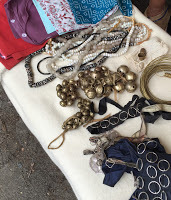
And, of course, I learned about clothes. According to Felicity Wite, above left, a member of the Lakota tribe and an interpreter at Colonial Williamsburg, trading with first the Spanish and later the Dutch, French, and British brought the world's goods to the Virginian woodlands. Cherokee men traded furs and skins for European cloth, clothing, ribbons, handkerchiefs, and beads (a sample is shown right) that were fashioned into new styles to suit their own tastes and culture. Trade bells, thimbles, wire, buckles, and even exotic peacock feathers were put to new purposes as ornaments and embellishments.

For example, Felicity is wearing a woven check shirt that would have been intended for an Englishman, but among the Cherokees was equally popular with both women and men. Beneath it she is wearing a skirt made from English Stroud cloth, a woven woolen that was popular as a trade cloth. Silk ribbons are stitched onto the Stroud cloth to make a decorative stripe, with the ends notched and left hanging as a kind of decorative fringe. The skirt ties at the waist with a leather thong or belt. On her feet are moccasins made of smoked, brain-tanned deerskin with wool-lined cuffs, embroidered with white glass trade beads.
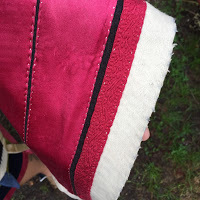
Another garment worn by both men and women (and soon adopted by Europeans on the frontier) was the match-coat. Originally made of fur, the match-coat evolved into a large rectangle of traded Stroud cloth that could be wrapped and tucked around the body to suit the wearer's needs and tastes. Felicity showed me one match-coat, middle left, that was richly embellished with ribbons with gold thread and a pattern of white beads. Another, lower right, was not only trimmed with ribbons and woven tape, but also made use of the Stroud cloth's undyed selvage, or edge; while Europeans hid the selvages inside seams, the Cherokees incorporated the white border into their designs.
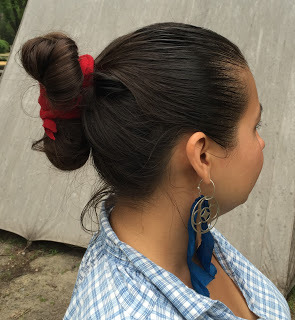
Felicity also explained that the women of each tribe had their own distinctive hairstyles. Hers was combed back into a sleek twisted knot, lower left, and tied with a length of red cloth. Her hoop earring featured an ornament of interlocking circles, a popular motif, while in her other ear she wore a dangling triangle. Jewelry could have been made from silver, copper, or an old tin pot; it was the shine that mattered more than the intrinsic European value of the metal. Extra color came from the blue silk ribbon tied into the hoop.
Three blocks away from Felicity and the other women of the encampment was the mantua-maker's shop, filled with the stays (corsets), hoops, heeled shoes, caps, and sweeping petticoats worn everyday by European women (like this .) There couldn't be two more different ways of dressing, and yet both represent fashions for Virginia in 1775.
Many thanks to Felicity Wite for her help with this post.
All photographs ©2016 by Susan Holloway Scott.
Published on June 06, 2016 21:00



